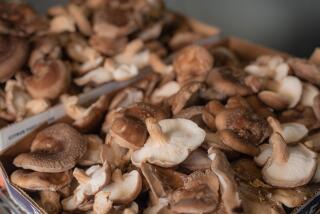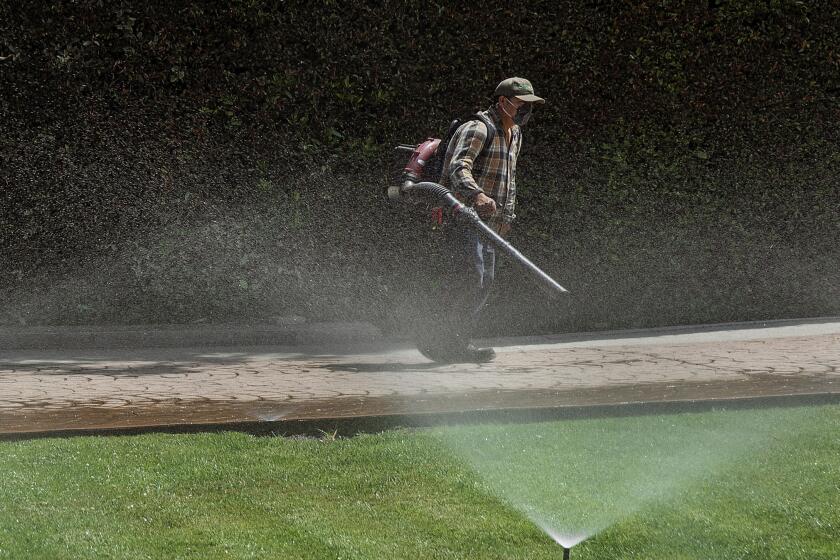Gourd Your Home
- Share via
If you have Martha Stewart tastes but not a lot of craft time, gourds may be your answer.
San Juan Capistrano artist Lynne Everett says these hard-shelled members of the squash family can be converted into holiday decorations, serving platters, plant containers, baskets, wind chimes, birdhouses, candleholders, lampshades and even bells.
Everett, who teaches gourd crafting classes, says that gourds can be decorated with common household items and that no special tools are required.
Another bonus--you don’t have to be an artist or even an accomplished crafter, says Ginger Summit of Los Altos, Calif., who has written several books on gourds.
“There’s no long learning curve,” says Summit. “The first time out will be a success. Gourds offer budding artists of all ages, including children, an easy-to-work-with medium that can be embellished quickly and easily. Every gourd is different, and there is no right or wrong way to work with it. A mistake can quickly be turned into an asset.”
You can decorate gourds by woodburning, painting, carving, staining or dyeing. Or simply polish them to a bright sheen with shoe polish.
You can also give gourds another dimension by attaching items such as beads, netting, plant pieces, string and leather, which is what Everett does.
“I’m also a basket maker, so I like to embellish gourds with natural materials I find in the garden, like date stems, grapevines and dried leaves,” she says.
She interlaces such materials in holes that she drills around the top of the gourds.
Gourds lend themselves to autumn designs, says Nangnoi Thomas, owner of Thomas Farms, a gourd farm and mail-order company in Lindsay, Calif. “I woodburn fall leaf designs into gourds and then use a leather dye,” she says. She also decorates gourds with acrylic paint. Gourds come in many shapes and sizes, from 1-inch minis to huge basket gourds. And the gourd determines the final look. “Although you may have an idea of what you want to make before you start, the gourd will lead you in the direction that you should go with it,” says Everett.
Gourd crafting isn’t new. Hard-shell gourds (Lagenaria) have been used for thousands of years as storage vessels, utensils, dishes, water and seed containers, vases and musical instruments. And they have been adorned with designs and patterns.
“Another great thing about crafting with them is the connection to the past that it gives you,” says Everett.
“Gourds are something that nature has provided for centuries, and this gives you a chance to carry on the tradition.”
Where to Get Gourds
The shiny, often bumpy gourds you see in the stores this time of year are ornamental gourds, which tend to have a thin shell and generally aren’t used for gourd crafting. You want hard-shell Lagenaria gourds, which can be grown in your garden or bought at gourd farms, where you’ll find different shapes and sizes.
Gourds that were grown this summer and harvested recently won’t be ready for decorating for two to six months, when they are dry.
If you want to try gourd crafting sooner, contact one of the following gourd farms and choose from last year’s stock. Most gourd farms offer mail-order.
Gourds generally range in price from $1.25 to $4 a piece, with very large gourds costing up to $30.
* Thomas Farms, 20947--B Avenue 245, Lindsay, (559) 562-9640. Mail-order and craft classes. They carry a variety of gourds, books and gourd crafting supplies and patterns.
* The Tree Mover Tree and Gourd Farm, 5014 E. Avenue N., Palmdale; (661) 947-7121. Mail-order. E-mail: treengourd@aol.com
* Welburn Gourd Farm, 40787 De Luz Murrieta Road, Fallbrook; (760) 728-0269, (760) 728-4271. www@welburngourdfarm.com. Mail-order.
* Rocky Ford Gourd, P.O. Box 222, Cygnet, OH; (419) 655-2152. Mail-order. Specializes in seeds, but some gourds are available. Seeds $2.50 a package.
* “Gourds in Your Garden,” by Ginger Summit (Hillway Press, 1997, $19.95) explains how to grow your own gourds.
Preparing Gourds
Gourds must be completely dry before they can be crafted. “You know a gourd is dry when the seeds rattle or the pulp thuds against the gourd’s interior,” says Doug Welburn, co-owner of Welburn Gourd Farm in Fallbrook. “Gourds ordered from a gourd farm now are from last year’s crop and will be ready for crafting.”
If you grew gourds this summer, you will need to wait until spring for them to dry for crafting.
As they dry, gourds become covered with a black mold. This must be removed before crafting. Follow these steps:
* Soak the gourd in warm water for up to 15 minutes, then scrub off the mold with a metal or plastic kitchen scrub pad. For many projects, the gourd is now ready to be cut and decorated, although you may also want to go over the shell with very fine wet/dry sandpaper to remove any blemish or rough spot.
* Cut the gourd shell to clean the interior. This can often be done with a sharp, sturdy kitchen knife. Most tools designed for woodworking are also suitable for gourd craft, such as a small keyhole or hobby saw, or a power saw. Before cutting, mark the line where you want to cut and stabilize the gourd on a foam pad or other soft surface.
* Remove the gourd top and pull out all the loose pulp and seeds. Save the seeds for planting in the spring.
Scrape out the pulp that is stuck on the interior of the shell with a serrated utensil such as a grapefruit spoon. When the gourd interior is clean, file and sand the cut edge of the opening.
A word of caution: Some people are allergic to the dust created when cutting, cleaning and sanding gourds. Wear a mask, and only cut the gourd in a well-ventilated room or outdoors. Squirting the gourd’s interior with water as you work will also minimize dust.






